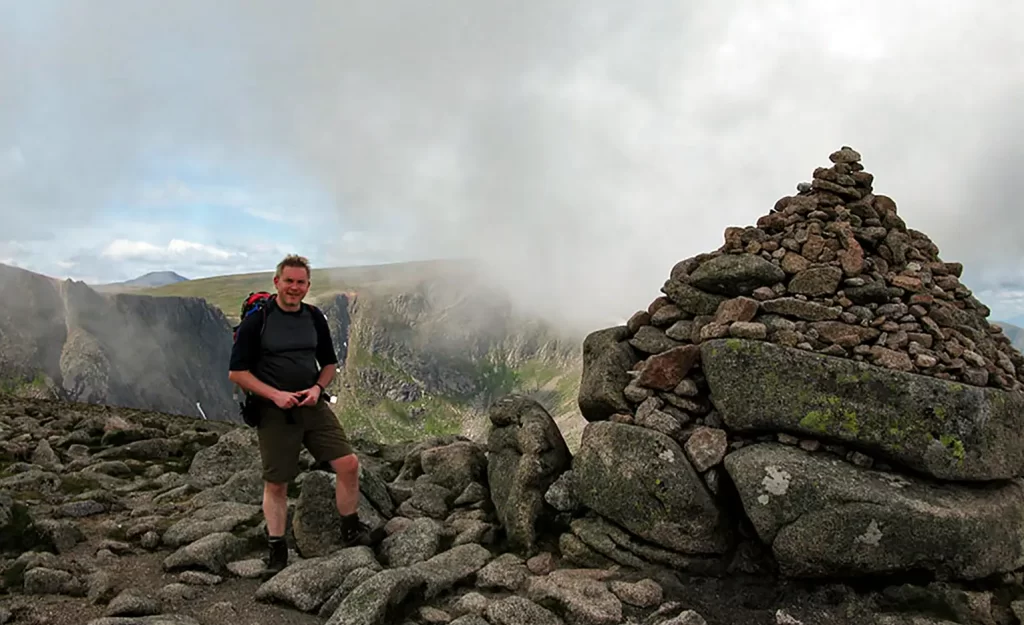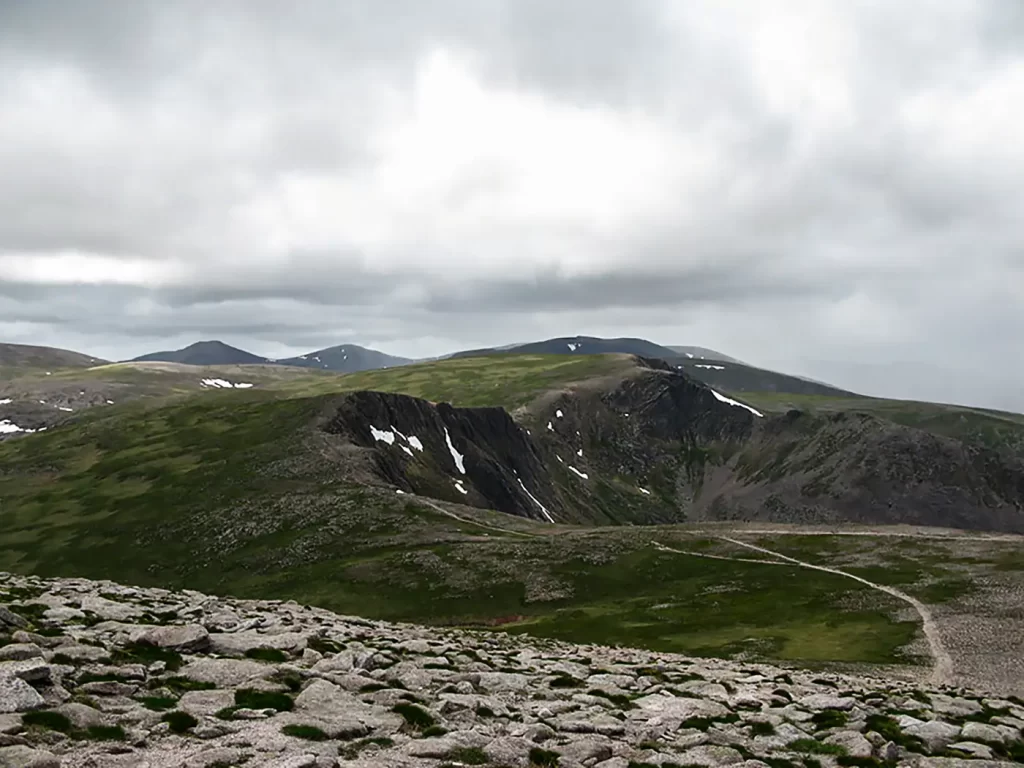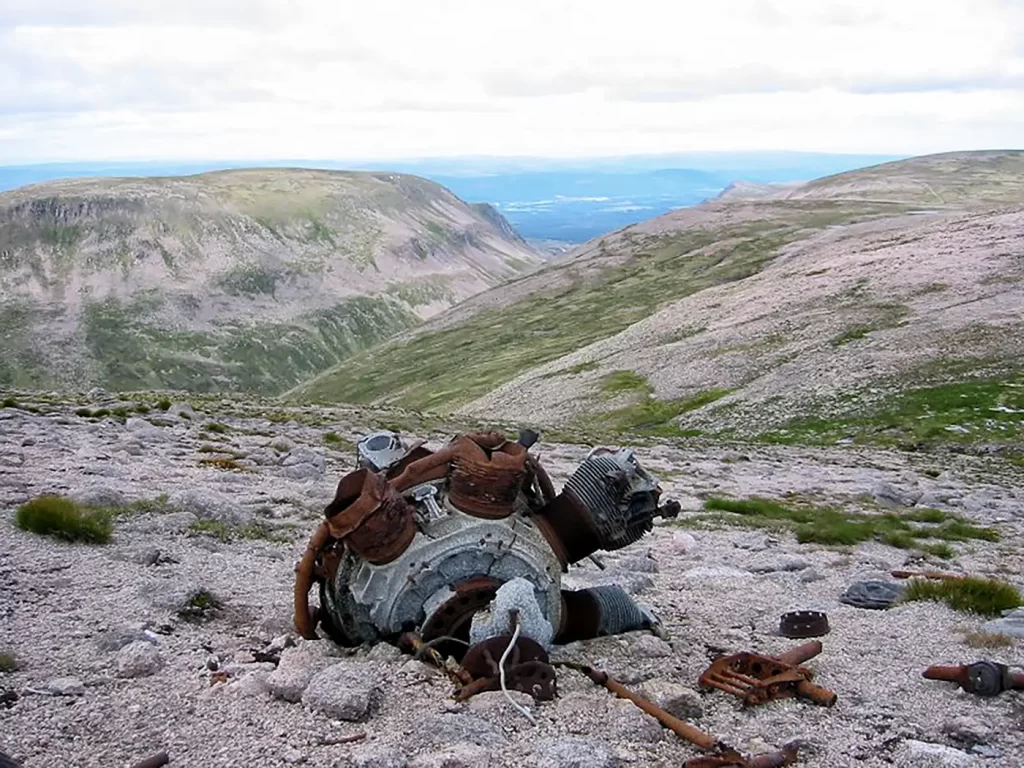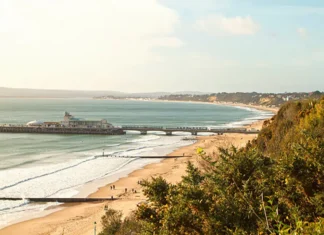
What does ‘wilderness' really mean? It only makes sense as a relative term – for instance, there is nowhere in the British Isles that can compare to Antarctica for a genuinely wild environment, in the sense that man has had minimal influence over it. There are however, parts of the British Isles that are wild in the sense that they contain no man-made structures, are only accessible by very long trips on foot and provide a haven for a small number of animals that require the absence of man.
Table of Contents
The harshest environment in the British Isles
The north of Scotland contains the wildest, harshest and most remote environments and wilderness in the British Isles, and as such these areas represent the greatest challenge for anyone venturing into them for whatever reason. There are large areas that are today completely uninhabited, although historically many of these areas were once well populated. The Scottish wilderness is in some ways not a relic of some mythical unspoilt past where nature held sway but is a testament to a more recent unsavoury event inspired by the worst of human impulses, namely the Highland Clearances.
Letterewe – remote wilderness
Leaving aside questions of whether one should feel guilt at the thought, it is very fortunate for modern inhabitants that such a relatively accessible wilderness exists in the British Isles. Perhaps the most outstanding wild landscape, the Cairngorm Mountains, offers large areas of land at the highest altitudes to be found. Despite the presence of a developed commercial skiing centre in one corner of the Cairngorms, the impact of modern civilization is minimal and the area is so vast that it is possible to walk for days without seeing anything of civilization. Further north, Letterewe offers one of the largest areas in Western Europe with absolutely nothing in it – no roads, bridges or farms; empty of everything but rough mountain slopes and rivers that require fording. The moors of Sutherland and Caithness do not even have the large number of mountain summits that land further south has, and hence do not attract the same number of walkers and mountaineers, further increasing the emptiness. Here then, is true wild land. To stand at the edge of a desolate area like this and contemplate walking across it with the prospect of meeting no one for days, of having no contact with the outside world (you can forget about mobile phone reception), and carrying enough on your back to be self-reliant until you get back to civilization requires nerve and preparation, but is undeniably exhilarating.
Some of these remote areas in the Scottish mountains, particularly areas like Letterewe or the large unnamed area in Easter Ross between Loch Broom and the Dornoch Firth, are so remote and unvisited even by walkers that to attempt to cross them in the depths of winter would require the same level of preparedness and willingness to suffer that would be required if one were to enter into the Canadian Arctic or Siberian wastes. The only difference perhaps is that a gun is not required to ward off polar bears.
Cairngorm Mountains
The Cairngorm Mountains in winter, particularly, can offer an environment to match much that is on offer in the more well-known ‘wild' places of the world. The Cairngorm range consists of three plateaux, separated by deep glens that were gouged out by glaciers during the last ice age. The amount of land in this plateau area that is above 1000 meters is larger than any other location in Britain, and it is often described as a sub-arctic environment. The landscape is relatively flat and featureless, and when snow-covered can represent the ultimate challenge for a walker. Add a blizzard or nightfall, and even the ability to use a map and compass is sometimes not enough. Many walkers have died in the Cairngorms in even relatively benign conditions.

What is the attraction of the Scottish mountains?
So what on earth is the attraction of the wilderness when there are these sorts of dangers? There are probably as many reasons as there are walkers. Beautiful scenery is certainly an attraction, but there are many parts of Scotland where amazing sights can be seen from the comfort of a car, like Glencoe or Skye. The walker who ventures into a part of the Scottish landscape that is many days walk from the nearest contact with other people is doing something a bit different from even those walkers who are climbing a hill on a day trip. They're putting themselves out on a limb, and this may be part of the reason why people are drawn to do it. It's a physical and mental challenge, a chance to pit one's wits against nature in a way that life in a city doesn't offer to modern people in the Western world. This can be particularly so if an expedition of this nature is undertaken alone, with all the dangers that that entails. The experience of being alone in a vast landscape that offers no human comforts and of being able to prepare for, endure and ultimately enjoy it can be a profound one. Whilst I don't believe the experience in any way approaches the spiritual or even the mystical (there are too many discomforts for that!), it is certainly something that can teach you something about yourself, your limits, and what is possible.
Be prepared for a good ‘yomp' to see the sights
Some sights in Scotland can only be seen by walking for a long distance into the wilderness. The falls of Glomach, the Corrieyairack and Minigaig passes, Cape Wraith, Loch Avon in the Cairngorms, the peaks of the Knoydart peninsula and Loch Coruisk on Skye are just some examples. If you haven't got a helicopter, and want to see some of the best parts of Scotland and perhaps get some good photographs, you have to be prepared to put a tent on your back and yomp for mile after mile.
To undertake such a trip into a wild and uninhabited area requires competence in navigation above all else. A fit person could survive for a few days without food, and water is often available in rivers in the Scottish mountains. A walker could even be lucky with the weather and not require waterproof or insulated clothing. However, if a walker were to venture into one of these areas without a map and compass, then the chances of the trip being a pleasant experience are minimal. Even more important than having these is the ability to use them well, i.e. to be able to navigate. It's often said by many wilderness experts that the best piece of equipment you can carry with you when entering a wilderness area is your brain.
Find your exact location on a flat plateau
Knowing where you are in this sort of landscape is an essential skill. It is all too easy to descend from a summit down the wrong ridge and at best, be faced with a long walk back to your starting point. Walking above the cloud base is very common in the Scottish mountains, so navigating by relating the locally visible topography of the land to the map features, and estimating distances walked on a compass bearing becomes necessary to avoid getting lost. Finding an exact location on a flat plateau such as the mountain summits that are to be found in the Cairngorms and the White Mounth area near Braemar can become an almost impossible task. This becomes important to walkers (such as Munro-baggers) whose main aim is the attainment of the exact location of a particular mountain summit. Munro-bagging is an activity that probably has more in common with train spotting than hillwalking. The proponents are often the same, being young men with too much time on their hands, and the process can, at its worst, degenerate into a grim list-ticking activity. The objective is to climb all the 284 summits in the Scottish Highlands higher than 3000 feet, but to achieve this many devotees would say that you have to stand on the highest point of the mountain. Arguments rage about what this means and what constitutes a distinct summit or indeed a mountain.
When to know if a summit has been bagged?
The question becomes, how close to the actual highest point does one have to be to claim that a particular summit is ‘bagged’? This can be a difficulty on certain mountains that have multiple peaks of similar height along a ridge or where the highest point is an indistinct area of a much larger flat plateau. When the cloud base is low or all features of the landscape are blanketed in a homogenous layer of deep snow, finding summit locations in these sorts of conditions can be next to impossible.
Climbing Creag Megaidh
A mountain which took me three attempts to attain the summit of is Creag Megaidh, near Glen Spean. On my first attempt, I walked up past the famous rock climbing cliffs of Coire Ardair and into the ‘Window', a narrow col just below the extensive summit plateau. I made it to within about 500 meters of the summit cairn, crawling on my belly in hurricane-force winds before giving up. My second attempt took me along a high ridge to the east of the main summit plateau with many subsidiary tops and cols. The cloud base was below the level of the ridge so I was walking in cloud and my estimations of how far along the ridge I had gone became less and less accurate. In these sorts of conditions, it is easy to overestimate the distance travelled, and also to subconsciously take the route that looks easiest, which is often the one that goes downhill. I ended up emerging from the clouds onto a ridge heading in the wrong direction many kilometres away from the main route to the summit. Although I wasn't in any danger, limited supplies of daylight and fitness reserves meant giving up the walk to the summit and retracing my steps back to my starting point. On a third attempt in November, I made it to the summit plateau but in the whiteout conditions finding the summit cairn on the large flat plateau was very difficult. After wandering around in circles for ten minutes, the cairn popped into view in a break in the swirling snow, and I finally ‘bagged' the summit, more by luck than design.
The modern walker and technology
The modern walker with some disposable income has options open to them now that walkers of even ten years ago did not have. A GPS receiver can be a vital walking aid. Although they do not replace the traditional tools of navigation such as a map and compass, they can be used to complement these and help to reduce the risk of getting lost. For many years I have walked all over Scotland without such a piece of equipment, and I resisted buying one because I thought it an unnecessary expense. Certainly, GPS receivers have disadvantages; they require batteries to work, so spares must be carried to ensure you can rely on it, it's an extra piece of equipment to carry and worry about losing or breaking, and they can offer an illusion of safety to those who don't take a map or compass with them into the mountains (news reports about rescues often mention that the walkers were not equipped with these).
A mobile phone is a mental connection back to civilization and it can be an extremely unwelcome intrusion to those trying to have a ‘wilderness experience'.
In some ways, there is a parallel debate amongst hillwalkers about the utility of carrying mobile phones into the mountains. Many walkers have been rescued quickly because they were able to contact emergency services even though they had little idea of their location. However, in many parts of the Scottish mountains (especially the high-sided glens) there is no mobile phone signal, and relying on one to get you out of trouble could be a very hit-and-miss affair, apart from which, one of the aims of walking in the mountains is surely to escape modern life and experience nature without the effects of man. A mobile phone is a mental connection back to civilization and it can be an extremely unwelcome intrusion to those trying to have a ‘wilderness experience'. There's nothing more bewildering and surreal than sitting on a summit soaking up an astounding panorama of mountains and glens stretching for many miles, whilst a fellow walker chats to their friends about the football scores.
Can't Beat a Good Map!
Having said that, a walker venturing into the mountains should probably not be without a mobile phone. Their usefulness in certain situations cannot be ignored. However, etiquette demands that the phone be turned off stored away and used for emergencies only. This is practical too – phones are of no use if the batteries have run down or they fall out of a pocket when fording a stream. The latest ‘smart' phones can be even more useful – with a good signal, some phones will allow a connection to the Internet and the possibility of viewing the latest weather maps and forecasts. Of course, there have always been low-tech methods of doing this as well, like carrying a small radio and listening to the forecast, but you can't beat a good map!
Mountaineering and GPS maps
As live weather maps might complement the traditional tools of mountaineering and hillwalking, so too will GPS maps. The ability to know your current coordinates using a GPS receiver and then to relate this to a traditional paper map is a powerful advantage to navigation, but now some modern handheld GPS receivers go further than this and have the ability to display colour maps on a display screen to show the current location and route graphically. The detail available with these GPS maps is now approaching that of the Ordnance Survey Landranger 1:50,000 scale mapping.
A few years ago, GPS signals (which originate from US-operated satellites) were intentionally filtered so that there was a considerable error in the location reading, of the order of tens of metres. In practical hillwalking terms, this can mean the difference between an exhilarating walk along a mountain ridge, or plunging over the edge. In 2000 this filtering was removed so that now positional accuracies of the order of 5 metres are attainable, and make navigation in the Scottish mountains using GPS safe and indeed can enhance the experience in many ways.

High-ground plane wrecks and relics
The ability to store locations in a GPS receiver as waypoints has other advantages apart from helping with the dubious pastime of Munro-bagging. On many of my walks in Scotland, I have come across twisted lumps of metal recognisable as aircraft parts, often very high up and sometimes right on the summit of mountains. Being intrigued by this, I purchased a copy of ‘High Ground Wrecks and Relics', a small book which lists details of aircraft (usually military) crash sites in the mountainous areas of the UK that still have wreckage lying around. There are a surprising number of these, most dating from the period of the Second World War and directly after. Using the book I was able to identify some of the wreckage I had seen, and because the book contained Ordnance Survey grid references to wreckage sites, I was able to visit some startling sites on subsequent walks, perhaps most notably the remains of a crashed Canberra Jet on the summit of the Munro Carn an t-Sagairt Mor near Braemar.
Not all of the sites are easy to find though, and often the remains are in several different locations. A single six-figure grid reference, of the sort given in the ‘High Ground Wrecks and Relics' book refers to a square measuring 100 metres on a side, so finding an exact crash site location on a mountain using this grid reference with a map can be a difficult task, particularly if the landscape has small ravines or boulder fields that wreckage may have fallen into. This is where using GPS waypoints will help and I hope in the future to visit some of the crash locations in Scotland and collect more accurate positional data using a GPS receiver.
Another type of interesting feature that a walker might see on walks in the countryside of Britain (although not high up in the mountains) is an ancient megalithic structure. These are often large stones that can be standing alone or arranged in rough circles and marked with ‘cup and rings' of uncertain origin. Although these sites are very numerous throughout Scotland, finding them amongst dense woods or modern human development can be very difficult. Julian Cope's ‘The Modern Antiquarian' is the best book for learning about and locating these fascinating sites, and this book also contains Ordnance Survey grid references. Again, the use of a GPS receiver to assist in finding some of these sites is a major advantage.
________________________________________________________________________
Eddie Boyle is currently working as a software developer at Edina, part of the University of Edingburgh on Go-Geo, a portal of geophysical data sources. Eddie climbs mountains in his spare time which he records in his blog. (http://www.edwardboyle.com)






